Bold visions for the future of Singapore's mature industrial estates have emerged from JTC's "Reimagining Singapore's Industrial Landscape" ideas competition. The initiative invited architectural, planning, and design professionals to submit innovative blue-sky ideas for the Yishun and Kallang-Kolam Ayer industrial estates, with the goal of transforming them into sustainable and vibrant communities. The proposals comprised a range of cutting-edge approaches to urban planning and design, offering a glimpse into the exciting possibilities to meet the evolving needs of a more sustainable manufacturing landscape.
Optimisation through multi-functional spacesCharacterised by predominantly single-use and low-density developments, both Yishun and Kallang-Kolam Ayer estates present opportunities for space optimisation and enhancements through the integration of industrial and non-industrial uses. New mixed-use urban models, building typologies and modular developments were proposed to create vibrant manufacturing landscapes as attractive work environments for young talents. The proposal for transparent factories would allow the public to be able to have a more immersive visitor experience viewing labs and production facilities first-hand and also serves as an avenue to promote industrial tourism.
Assessing the potential of such models and typologies serves as a pertinent step towards creating more sustainable and vibrant workspaces that meet the needs of Singapore’s growing population while also addressing the pressing issue of land scarcity.
Planning for the future of industry and manufacturing
As industrialists increasingly adopt automation and digitalisation, it presents an exciting opportunity to explore new planning paradigms that help JTC’s estates remain adaptive to emerging trends and future technologies. The ideas explored how Yishun and Kallang-Kolam Ayer industrial estates could adopt the concepts and principles of Industry 4.0 and 5.0 by better synergising human and machine work ecosystems. This included integrating technologies such as autonomous ground vehicles and sensor-laden collaborative robots that can work alongside humans to create more efficient and sustainable production processes in the estates.
Repurposing industrial buildings for new use
The adaptive reuse of existing industrial buildings presents a sustainable alternative to demolition and new construction as it can reduce waste and conserve resources. It also preserves the heritage of the estate while integrating it with the larger community. Several proposals explored the repurposing of key buildings that exhibit cultural and historical values. For example, in Yishun, the existing row of JTC’s flatted factories facing Sungei Simpang Kiri has been identified for rejuvenation and repurposed as a riverfront SOHO. Another proposal explored the transformation of JTC's Terraced Factories at Kallang Way 5 into an ‘Innovation Ground’, a co-working and living space for the community.
Activating green and blue networks
As a fundamental pillar of JTC's work, sustainability is a crucial consideration in the development of each estate. Building on the existing waterways, the proposals present ways to activate the area’s green and blue networks to seamlessly connect the industrial estates with the surrounding residential neighbourhoods. The competition also served to explore ways to enhance biodiversity and harmonise nature with urban infrastructure.
These networks incorporate urban greening strategies, biophilic building designs, and leveraging the waterways including Kallang River, Pelton canal, and Sungei Simpang Kiri for recreation and as an alternative mode of transport. The integration of green and blue networks can provide a range of benefits, including improving air quality, promoting biodiversity, and mitigating the Urban Heat Island Effect for the community.
Ms Tang Hsiao Ling, Director of Urban Planning & Architecture Division, JTC, said, “With Singapore's limited land, it is critical for JTC to continuously look at new ways to optimise industrial land. In master planning industrial estates, we also need to ensure the planning and development of such infrastructure remain agile and is sustainable over the long haul while marrying the needs of different industries and their surrounding communities. The bold concepts put forth for Yishun and Kallang-Kolam Ayer industrial are inspiring in envisioning how the future of mature industrial estates may look like. These are places where urban ecosystem melds with nature, where businesses unite for synergised growth, and where people forge connections that ignite innovation and a sense of community.”
A total of 26 proposals were submitted for the competition, out of which seven were shortlisted. The shortlisted proposals are exhibited at the URA centre from now until 20 October as part of Archifest, an annual festival organised by the Singapore Institute of Architects. Members of the public are invited to provide their feedback to jointly shape the future of Yishun and Kallang-Kolam Ayer industrial estates by visiting go.gov.sg/archifest2023exhibition.
JTC will review proposals received from the competition and identify suitable ideas to help in the future planning of Yishun and Kallang-Kolam Ayer, as well as other mature industrial estates in Singapore.
Annex A: Proposals for ‘Reimagining Singapore's Industrial Landscape’ Ideas Competition
1. Optimisation through multi-functional spaces
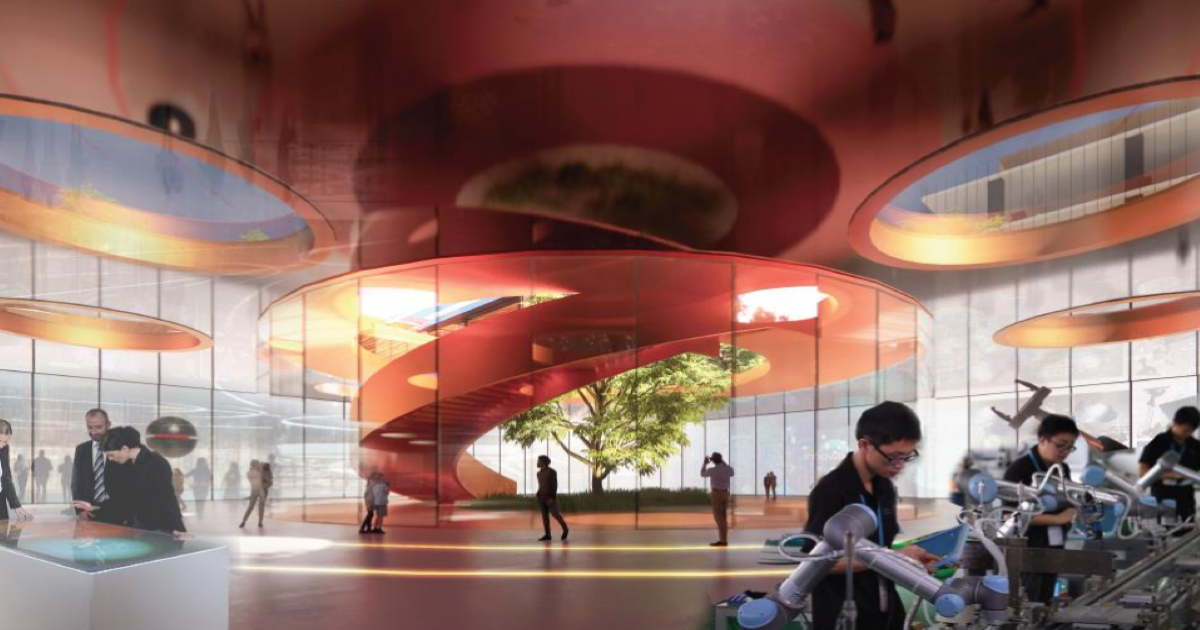
Artist’s impression of the underground gallery space of a transparent factory at Kallang-Kolam Ayer industrial estate (Credit: Broadway Malyan)
Broadway Malyan’s “Singapore Makers Land” explores the introduction of transparent factories, where the ground floor spaces of industrial developments are made more porous to engage the public. Showrooms and product galleries offer a more immersive visitor experience, allowing the public to interact with innovative production processes and even customise their own designs and products. On top of the factory, large greenery public spaces are introduced to bring public interaction closer to the buildings to promote better integration of spaces.
2. Planning for the future of industry and manufacturing
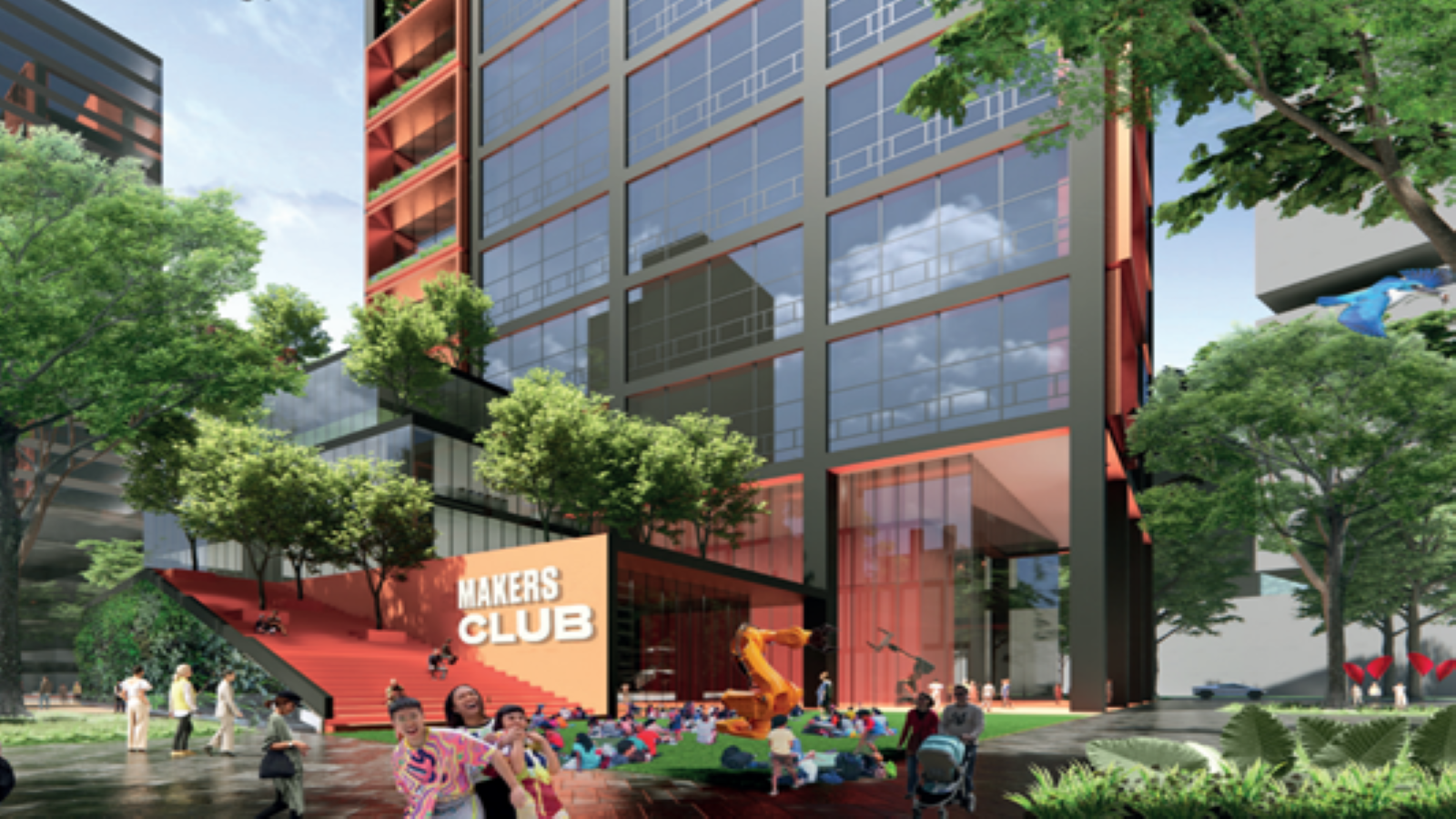
Artist’s impression of ‘The Summit’, a space at the western edge of the Kallang estate (Credit: Broadway Malyan)
In Broadway Malyan’s “Singapore Makers Land”, The Summit is a unique space where humans and robots interact seamlessly, with machinery being just as much of an inhabitant as the workers around which the factory is designed. Utilising automation, these robots complement human operations and act as a ‘tag team’, enabling the Kallang-Kolam Ayer industrial estate to be transformed to cater to high-tech industries.
3. Repurposing industrial buildings for new use

Artist’s impression of the phases of adaptive reuse of developments along Sungei Simpang Kiri (Credit: Arup)
Arup’s “The Intersections” explores the adaptive reuse of existing developments along Sungei Simpang Kiri, including the row of JTC’s flatted factories, by repurposing them from industrial use to residential. The adaption will involve changes to the structural works of the existing development in stages, as well as extensions along the canal to be developed into a riverfront SOHO.
4. Activation of green and blue networks
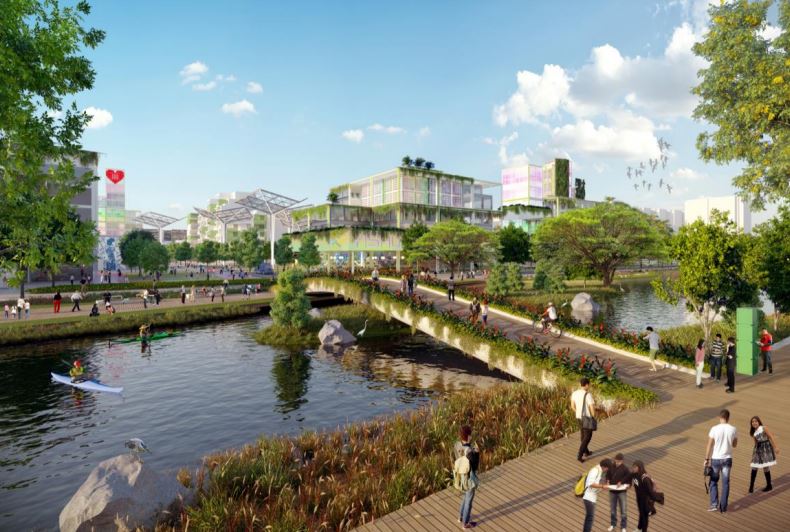
Artist’s impression of Sungei Simpang Kiri at Yishun industrial estate (Credit: Arup)
“The Intersections” by Arup explores the activation of an extensive green and blue network that connects the Yishun industrial estate to surrounding neighbourhoods. The aim is to create an attractive ‘industry in nature’ that is ready for climate change. Here, urban greening plays a crucial role in achieving this goal, not only by creating a vibrant green neighbourhood but also by mitigating the heat generated in the estate. Sungei Simpang Kiri is enhanced through the addition of elements such as bridges, extended boardwalks, paths, and a cycle track. The canal is transformed into a mix of tranquil and lively spaces suitable for all types of activities and uses.
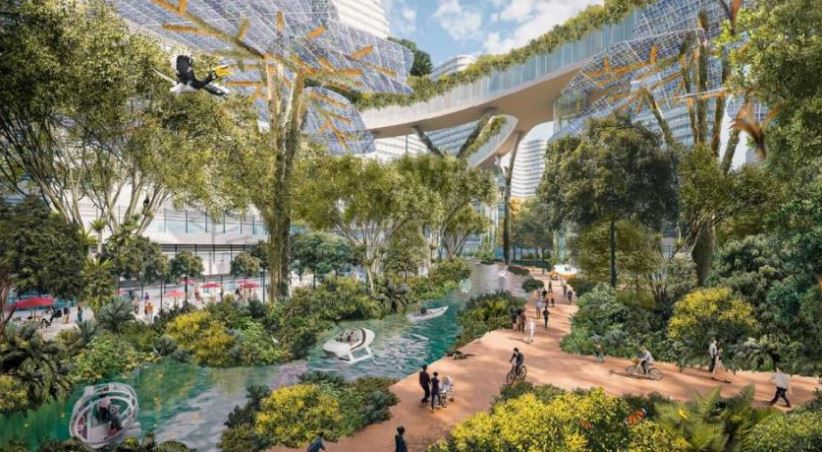
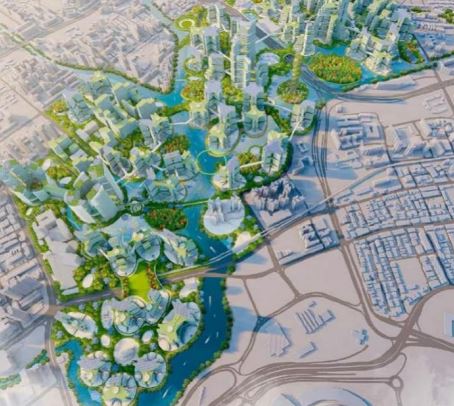
Artist’s impression of enhanced green and blue networks at Kallang-Kolam Ayer industrial estate (Credit: WOHA)
In WOHA’s “River, Island, Jungle”, 50% of land in the Kallang-Kolam Ayer industrial estate is set aside to integrate as much greenery into the estate as possible on the ground, mid-level and roof level, thereby bringing forest strata and biodiversity vertically upward. The urban massing is designed in response to nature’s ways, incorporating the forest floor, understorey layer, canopy layer, and emergent layers, each with its own rich biodiversity. The proposal also explores the use of water transportation as part of Singapore’s future mobility networks, with a W-line network for water-based personal mobility devices, water ferries, and taxis that run through the entire estate.
4. Video proposals for Yishun and Kallang-Kolam Ayer industrial estates from Arup and Broadway Malyan
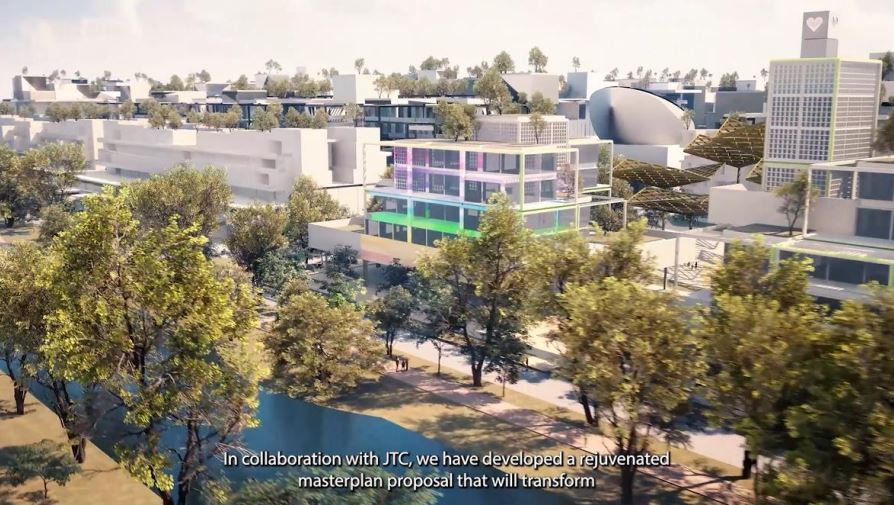
Screenshot from Arup’s ‘The Intersection’ proposal for Yishun industrial estate.
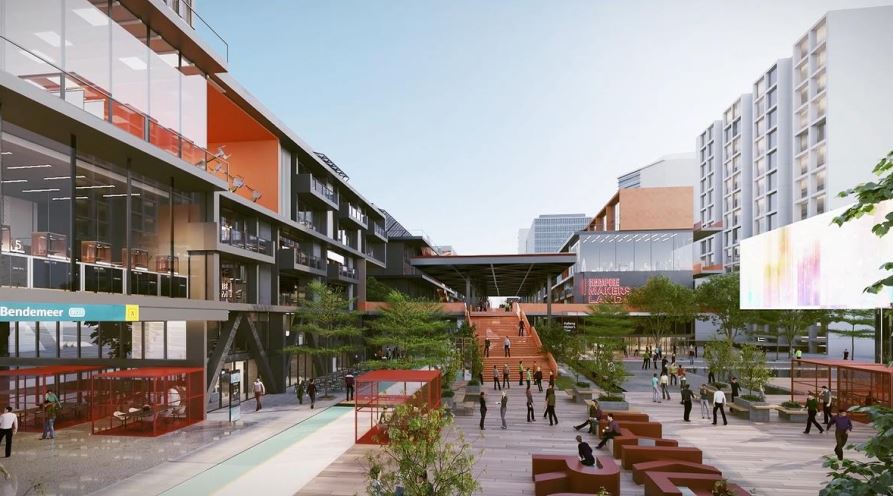
Screenshot from Broadway Malyan’s ‘Singapore Makers Land’ proposal for Kallang-Kolam Ayer industrial estate.
The full videos can be accessed here
Annex B: About the ‘Reimagining Singapore’s Industrial Landscape’ Exhibition at URA

Blue-sky Ideas for Rejuvenating Mature Estates
To explore ways to optimise land, create new spaces for growth industries, and devise conducive work environments, JTC called for a Request for Proposal and invited local and international design professionals to submit concept proposals for the rejuvenation of two mature industrial estates: Yishun and Kallang-Kolam Ayer.
This exhibition showcases the exciting blue-sky ideas that reimagine what manufacturing in a city can be. The ideas present different visions and strategies for brownfield redevelopment and the benefits it brings, including improved connectivity within the estates, injection of street life vibrancy, more greenery and biodiversity reintroduced into the urban fabric, as well as the creation of spaces that foster a sense of community.
